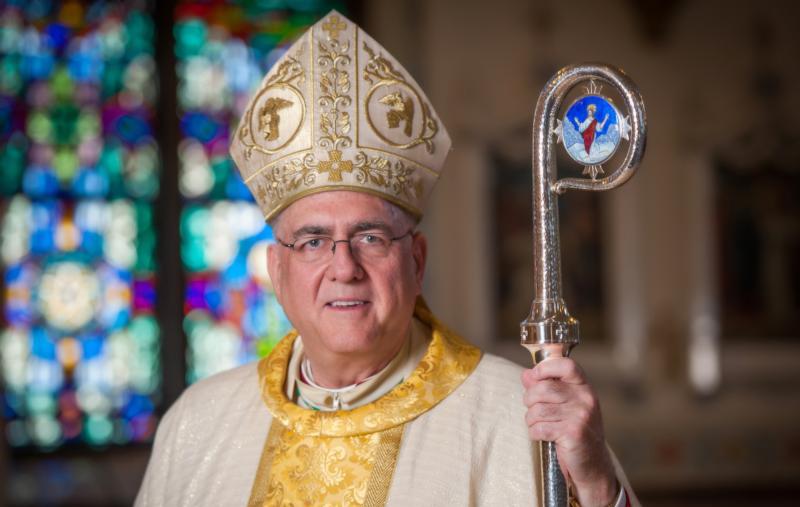
by Archbishop Joseph F. Naumann
Last week, I concluded my column regarding vaccines with the reminder that ultimately medicine, science and technology cannot protect us from the reality of death. At best, they can extend our lives, but death still comes for us all. The risen Jesus defeated death and only by sharing in his eternal life can we overcome death’s sting.
We live in a risk-averse culture. We believe our bodies are designed to be temples of God. Thus, we have an obligation to take prudent care of this temple.
At the same time, Jesus does not promise his disciples we will never experience adversity and difficulty. Jesus warned his disciples that if we wish to follow him, then we must be prepared to take up the cross. A disciple must follow Jesus all the way to Calvary.
Jesus invites us to participate in a great adventure. Adventures are not free of risk but, by their nature, involve risks. Jesus promises that he will be with us, especially at times of adversity and difficulty.
If we take the risk of following him, then we will experience abundant life (a life filled with meaning and purpose) in this world and eternal life with him and the saints on the other side of death.
If we take the risk of discipleship, how do we know that the Resurrection is true? Atheists refer to religion as the opium of the people, promising a fantasized life after death to keep people content and docile with the injustices and inequities in this world.
Some intellectuals in the past 200 years have attempted to create doubts about the veracity of the Resurrection. How do we know the resurrection of Jesus and his promises of eternal life are true?
Contradicting the claims of the gurus of the so-called Jesus Seminar and some of the pseudo documentaries on cable television, the evidence for the historical truth of the resurrection of Jesus is quite strong and persuasive. “The Case for the Resurrection of Jesus,” by Gary R. Habermas, Ph.D., and Michael R. Licona, Ph.D., provides very compelling arguments for historical data that supports the historicity of the resurrection of Jesus.
Habermas and Licona identify five key facts: 1) Jesus’ death by crucifixion; 2) the disciples’ belief that Jesus appeared; 3) the conversion of the Christian persecutor Paul; 4) the conversion of the skeptic James; and 5) the empty tomb.
The first four facts are supported by nearly every scholar, even skeptical ones. The empty tomb enjoys a significant majority of scholarly support, but does not have the same universal acceptance as the first four.
Habermas and Licona detail how both the New Testament literature, the oral tradition, the written non-biblical early Christian tradition and contemporary non-Christian historians agree: 1) Jesus died by crucifixion; 2) his disciples believed the risen Lord appeared to them; 3) Paul, a persecutor of the early church, became a zealous Christian apologist because of his own personal encounter on the road to Damascus with Jesus; and 4) James, a skeptical cousin of Jesus, is converted in part by the post-resurrection appearances of Jesus.
This past Sunday’s Gospel recounted one of the risen Lord’s appearances to his disciples. The passage begins with the two disciples on the road to Emmaus relating their encounter with the risen Jesus and their recognition of Our Lord in the breaking of the bread — the Eucharist. In the midst of describing their experience, the risen Jesus appears to the assembled disciples.
The immediate reaction of the disciples was terror because they assumed that they were seeing a ghost. Jesus, as he does in most of his post-resurrection appearances, displays the wounds of the crucifixion and invites the disciples to touch him, reminding them that ghosts do not have flesh and bones.
Jesus then asks them if they have anything to eat. Ghosts do not get hungry, much less eat.
The disciples give him a piece of baked fish that Our Lord eats. Jesus explains how his crucifixion and resurrection were all foretold in the teaching of Moses, the prophets and the psalmists. Our Lord commissions the disciples to become witnesses of his death and resurrection to the world.
One of the strongest arguments in favor of the resurrection was the transformation of his disciples. The same group, who were so afraid and cowardly during Jesus’ passion and death, fleeing in fear — and, in Peter’s case, denying he even knows Jesus — in the post-Easter and post- Pentecost accounts boldly proclaim the risen Lord.
In last Sunday’s first reading from the Acts of the Apostles, Peter was preaching fearlessly in Jerusalem. Peter was not attempting to soft-pedal the events of Our Lord’s passion, nor was he attempting to ingratiate himself with the Jewish crowds or the Jewish authorities.
Peter declared: “The God of Abraham, the God of Isaac and the God of Jacob, the God of our fathers, has glorified his servant Jesus, whom you handed over and denied in Pilate’s presence when he had decided to release him. You denied the Holy and Righteous One and asked that a murderer be released to you. The author of life you put to death, but God raised him from the dead; of this we are witnesses.”
This is a changed Peter from the one who said in the courtyard of Caiaphas: “I do not know the man.”
If the resurrection is true, then the only thing we have to fear is not being a faithful disciple of Jesus. Earthly powers, pandemics, economic challenges and physical illnesses cannot intimidate us. The disciple of the risen Jesus is never without reason for both hope and joy. Jesus has defeated death and won the victory of life. Of whom or of what should we be afraid?
Jesus is risen, alleluia!

